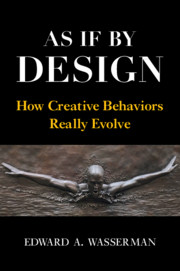Book contents
- As If By Design
- As If By Design
- Copyright page
- Dedication
- Contents
- Figures
- Acknowledgments
- Section 1 Introduction
- Section 2 The Vignettes
- Part I Sports
- Part II Medicine
- Part III Hygiene
- Part IV Arts, Entertainment, and Culture
- 16 Ansel Adams
- 17 Basil Twist: “Genius” Puppeteer
- 18 Moonwalking: And More Mundane Modes of Moving
- 19 Play on Words
- 20 Cuatro Festivales Españoles
- 21 Tchaikovsky
- 22 The Evolution of the Violin
- Part V Is This Heaven? No, It’s Iowa!
- Section 3 Putting It Together
- Index
- References
22 - The Evolution of the Violin
Survival of the Fittest or the Fondest Fiddle?
from Part IV - Arts, Entertainment, and Culture
Published online by Cambridge University Press: 01 July 2021
- As If By Design
- As If By Design
- Copyright page
- Dedication
- Contents
- Figures
- Acknowledgments
- Section 1 Introduction
- Section 2 The Vignettes
- Part I Sports
- Part II Medicine
- Part III Hygiene
- Part IV Arts, Entertainment, and Culture
- 16 Ansel Adams
- 17 Basil Twist: “Genius” Puppeteer
- 18 Moonwalking: And More Mundane Modes of Moving
- 19 Play on Words
- 20 Cuatro Festivales Españoles
- 21 Tchaikovsky
- 22 The Evolution of the Violin
- Part V Is This Heaven? No, It’s Iowa!
- Section 3 Putting It Together
- Index
- References
Summary
Pyotr Ilyich Tchaikovsky is one of the world’s most beloved composers. Yet, his greatest work remains his most enigmatic. Tchaikovsky’s Symphony No. 6 was the last major work he completed before his untimely death at the age of 53. Its title is the Pathétique, which in French means passionate or emotional. The symphony certainly lives up to that title, particularly its fourth and final movement. Unlike the traditional boisterous or triumphant climax of a major symphony, Tchaikovsky experimented with an extended lament. Not only that, but the first few lines of the movement introduce the melody in an unprecedented way: distributed across the first and second violins so that no individual instrument actually plays the melody. In other words, this “emergent melody” is heard but not explicitly played! Why would Tchaikovsky introduce such a peculiar innovation? Efforts to answer this question have yet to succeed.
Keywords
- Type
- Chapter
- Information
- As If By DesignHow Creative Behaviors Really Evolve, pp. 250 - 256Publisher: Cambridge University PressPrint publication year: 2021

